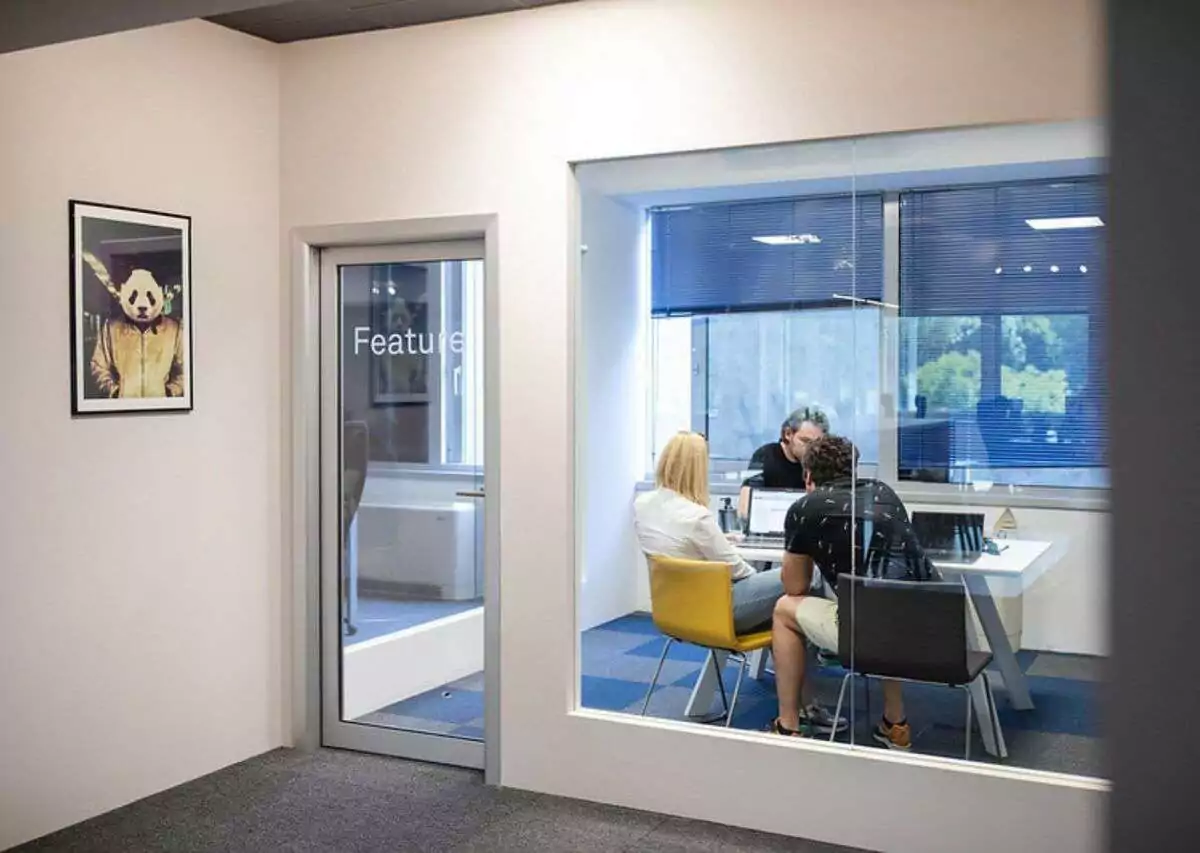To make a clear decision take a look at our comparison.
8 things to do when choosing an outsourced app development company
You’ve decided you want to outsource the development of your app to be.
But the IT outsourcing market (worth around 526.6 billion dollars in 2021) is a hotchpotch of the best players, the two-bits and those in the middle.
Choosing the right app development company isn’t just a quick skim through Google.
It takes time and a good amount of critical thinking.
When done systematically, you’re setting up your future app for success.
Focusing on these 8 crucial factors will bring you a step closer to the company that will be a match for your app.
Table of Contents
First things first: why it’s important to choose wisely
A bad outsourcing partner can lead to complications in all stages of development, and cause critical issues such as:
- Overhead costs
- Low-quality final product
- Communication problems
- Extended deadlines
Let’s say you choose a company just because they were cheaper than the rest. Somewhere down the road, you realize the code is of low quality, bugs abound or the company keeps on pushing deadlines.
Not only can you waste money (even though it seems cheaper at the beginning), but also time and manpower. Similar or same problems can happen if you choose a company without viewing the whole picture.
Now that we got that out of the way, let’s dive into the steps you need to do before choosing an outsourced app development company.
Choose between offshore, nearshore, or onshore
The location of the outsourced app development company is one of the first things to consider.
You can choose between three types of outsourced companies:
- Onshore companies
- Nearshore companies
- Offshore companies
The main differentiator is the location.
If your firm is based in the USA, app development companies located in Europe, India or Oceania are offshore.
However, companies located in Canada or Mexico are nearshore, while companies located in the USA are onshore because, obviously, you’re both located in the same country.
All of them have their benefits. In the end, it all comes down to what suits you the most.
Benefits of offshore companies
Pricewise, offshore companies are the most affordable of the three, especially if you’re located in a country with a stable and growing economy (e.g. USA, Western Europe).
A lower price doesn’t have to mean low quality. Brilliant and talented developers and other IT experts work in affordable companies.
Benefits of nearshore and onshore companies
You can be in direct contact with representatives and developers. That includes visiting the company’s headquarters where you can meet the team and connect with them more palpably than on video or the phone.
When communication is fast, any kind of problem is easier to solve.
Now that you have an inkling of where your potential outsourcing partner may be located, narrow your focus.
Look at their website, portfolio, and case studies
What’s the first thing you click when you google a company?
Exactly – the website.
If you can’t find an official website, you cross them out immediately.
Your website is the face of your company.
Companies that are aware of that, make sure they put all relevant information there. You can see how their working space looks, the team members, the projects they’ve worked on, and even case studies.

One of the most important things to look out for when browsing through the app company’s website is to check whether their past projects have anything in common with your app.
If the company’s projects or case study section is made of similar projects, it means they’re experts on the matter.
Let’s say you are looking for a company that specialized in fintech. If one company has mostly fintech projects and the other one has a more “colorful” portfolio, you’d definitely go with the first one.

Need high-end mobile app development from true experts?
We’re a full-service partner to the world’s most ambitious companies — Let’s talk.
The more specialized the company is, the more you can save time and resources and build a high-quality mobile app.
However, if your project requires more skill sets, do-it-all companies can seem tempting. Make sure you investigate them thoroughly because jack-of-all-trades companies can lack focus and in-depth expertise.
GitHub
If a company doesn’t have a large portfolio section on its website, chances are there’s more information on GitHub.
Lots of developers and companies showcase their best projects on GitHub because it’s the largest web platform for code hosting. It boasts 40 million users and more than 190 million repositories.
Accessing portfolios may feel like you’ve entered a maze, so if there isn’t a link to the company’s GitHub profile, ask for it or move on to another candidate, if you don’t have time.

Source: GitHub
Don’t be blue if you can’t find as many work examples as you initially thought you would. A thin portfolio or a lack of it can mean that the company has an NDA with its client so they can’t showcase their project.
In those cases, the old-fashioned way of knocking on their virtual door is the most effective.
Everyone will say their product is the best, but the end-users, in this case, the clients, can give you more objective information about a company.
See what their clients say about them
Take a (metaphorical) step outside your head – check out what others say about the company. The best people for that are the company’s past clients.
Luckily, living in the age of the internet means you can find testimonials very quickly.
Most websites have a testimonials section on their website, but it’s always best to read them on third-party websites, like Clutch.
Only verified companies can join and their profiles include client reviews, ratings and portfolios.

Source: Clutch
The companies are not the only ones who get verified, but the reviews too.
If you want to leave a verified review on Clutch you have to register with your Linkedin profile. The other option is to leave a review via the good ol’ phone call with a Clutch representative.
A good way to keep away those bots, right?
Goodfirms
Here’s another review site focused only on the iT industry. Although Clutch is the more popular of the two, you won’t waste time if you double-check a company and explore the reviews and ratings on this site too.
If you want to narrow down your search, make use of the customized list of companies in your preferred category.

Source: GoodFirms
Let’s look at platforms that showcase reviews from employees and other stakeholders.
With over 800 million users and 57 million registered companies, Linkedin is your go-to for researching potential outsourcing companies. You can get a pretty good picture of a company, but also its employees.
By checking out what people post and comment you can at least get an inkling of whether they’d fit in with your project.
Make sure to check out the Recommendation section of people’s profiles. But don’t take it for granted. Sometimes friends leave each other recommendations so it’s wise to check out the profile of the person who gave the recommendation.
Glassdoor
Do you want some inside information? No, you don’t need to bribe an intern. Just check out the company’s Glassdoor profile.
Former and current employees leave reviews and rate companies. By reading through the reviews, you’ll get as an objective insight as possible into the inner workings of a company. That way you can visualize how your own cooperation with the company will look like.

Source: Glassdoor
Reviews are a goldmine of information because you can read in the client’s own words how the project went. You also get both the good and the bad experiences so it’s easier to make an informed decision.
If the company has more negative than positive reviews, move on with your quest.
When you get a good glimpse of the company, it’s time to think about the price.
Ask about their pricing model
The part you’ve all been waiting for – the price.
Money is a make-or-break factor when choosing an app development company.
The pricing model will depend on the requirements of your project.
Also, not every company has the same pricing model.
Time and materials
- Flexible
- Best for bigger projects
- Projects divided into separate tasks
- Client has control over the process
Fixed price
- Best for smaller projects
- Inflexible
- Lots of paperwork
- Extra charging of changes
Here’s a breakdown of the two most common ones.
Fixed price
As the name suggests, this pricing method is based on establishing a fixed price for the whole project. Price isn’t the only thing that’s fixed, also included are the deadlines and app requirements.
Although clients prefer this model because they’re afraid of the overhead costs, it’s not perfect for either side.
The development process is not as clear-cut as it may seem. Developers may have to tackle things that can sidetrack them – bugs or device incompatibility.
These ups and downs of the development process may later lead to
- Miscommunication
- Conflicting interests
- Inflexibility
So building a high-quality app until the fixed deadline becomes almost impossible.
Most of these problems happen with bigger and more complicated projects. However, if you’re dealing with a small-scale project, or you’re looking for an agency that will build an MVPFor for smaller projects with certain costs the fixed price model fits the best.
Time and material
If your project is on a middle or large scale, all the disadvantages of the fixed price model are gone in the time and material model.
In a nutshell, this model is based on setting a fixed development team’s capacity and their respective daily cost.
T&M is much more flexible than the fixed price, especially when dealing with big projects with an unpredictable scope.
You can change the rates according to changes in the project, whether it features, changes within the team, or other unforeseeable factors.
This is always done together with the outsourced company so everything is transparent. Also, it’s easier to gain mutual trust.

When it comes to pricing, the most important aspect is whether it’s simple and flexible enough for all the changes that occur during the development process. That’s why the T&M model is the most popular pricing model in outsourcing development.
But what about the development process itself? We’ll talk about that next.
Check out the company’s development methodology
In order to successfully build an app, you must have a fool-proof way of developing it.
The whole process has to be quantifiable, and systematic and steps should be made always in the same order.
An effective and sustainable methodology of software development has a lot of benefits, including
- Faster delivery of the product
- Increased productivity of the developing team
- Saving time
When choosing your outsourcing partner, make sure you’re on the same page regarding the methodology.
Let’s say you’ve always followed the waterfall model, but the development team builds software using the agile approach.
In that case, meeting halfway is crucial. So either you should adapt to their workflow or vice versa. If the company is ready to adjust, this means that they’re open and flexible – all good signs of a trustworthy company.
You can also check on the company’s website whether they have a document or a blog that details their work processes.
A well-written and thorough workflow is a huge plus. Other than showcasing the company’s professionalism, it educates the client and instills even more trust in the company.
The more transparent and detailed the workflow, the better the final product.
Find out everything about their security measures
According to a survey, 75% of mobile applications will fail basic security tests.
That’s why one of the key things to do when choosing a company is to find out how they manage security in their apps.
It would be perfect if they use software testing life cycle (STLC) because it’s based on the premise of testing the app in all stages of development. When applied correctly, bug solving is faster and the overall quality of the app is always top-notch.

Make sure the company also does:
- Data encryption
- Additional authorization (two factor authentication – 2FA)
The app itself isn’t the only thing that needs to be secure. When dealing with outsourced companies, make sure each side signs an NDA (Non-disclosure agreement).
This legal document ensures any sensitive information related to your app is confidential.
When drafting an NDA, make sure to include these elements:
- Names of the parties involved in the project
- Definition of the confidential information
- The purpose of the document
- Requirements and obligations
- Exclusions from confidentiality
- The time periods involved
- Consequences in case of the NDA’s breach
A ISO-27001 certification is also a clear sign that the company takes security seriously, not only regarding their apps but also finances, personal information, intellectual property, and other sensitive data.
This gives you an even greater sense of security and trust in the company.
In the long run, taking care of the security of your project will rid you of headaches and hours, even days, spent on mending security leaks.
Ask for the CVs of the app development team
You’re not choosing a company, you’re choosing people who will build your app.
With that in mind, it’s a good idea to ask for the CVs of all of those who could be involved in the project.
One of the first things clients look for in a CV is the developer’s experience in a programming language.
As in most jobs, the more experience they have, the better. But it’s also best to actually see what projects they’ve worked on.
More and more developers showcase their skills and projects on GitHub. If the developer has a GitHub profile, it should be included on the CV.
If not – ask for it.
Talk about app testing and maintenance
Everyone thinks about the goal, but not what comes after it.
The same goes for app development.
Bugs happen, users and app trends change, maintenance and testing have to be made so your app also must go with that (chaotic) flow.
In real life, a whopping 95% of users uninstall a mobile app within 90 days, so having someone take care of the post-launch period is crucial for not letting your app become a drop in a sea of thousands of unused apps in Google Play or App Store.
At DECODE we boast of a growing team of qualified app testers because we are aware that quality assurance is a must-have in all of our projects.

On top of that, there is no project where we don’t have at least one QA on board.
So when choosing an app development company make sure to ask potential candidates whether their services include app testing and maintenance.
In the end, it’s all about the people
Finding the perfect app development company is not a stuff of fairytales. It’s indeed possible. Make sure you keep track of these 8 factors:
- Location of the company
- Explore their website
- Client testimonials and reviews
- Pricing model
- The company’s development methodology
- Security measures
- Experience of developers
- Testing and app maintenance
However, at the end of the day, you’ll be working with people. So you should always make sure you have assembled a team with skill sets appropriate for your app. Also, the more dedicated they are to the project, the better the end result.
That’s the reason why clients love to work with our developers and QA experts.
So if you’re too looking for a dedicated team that will be a fit for your mobile app say hi to us!



